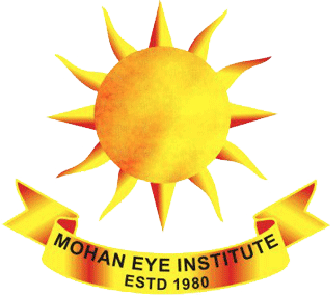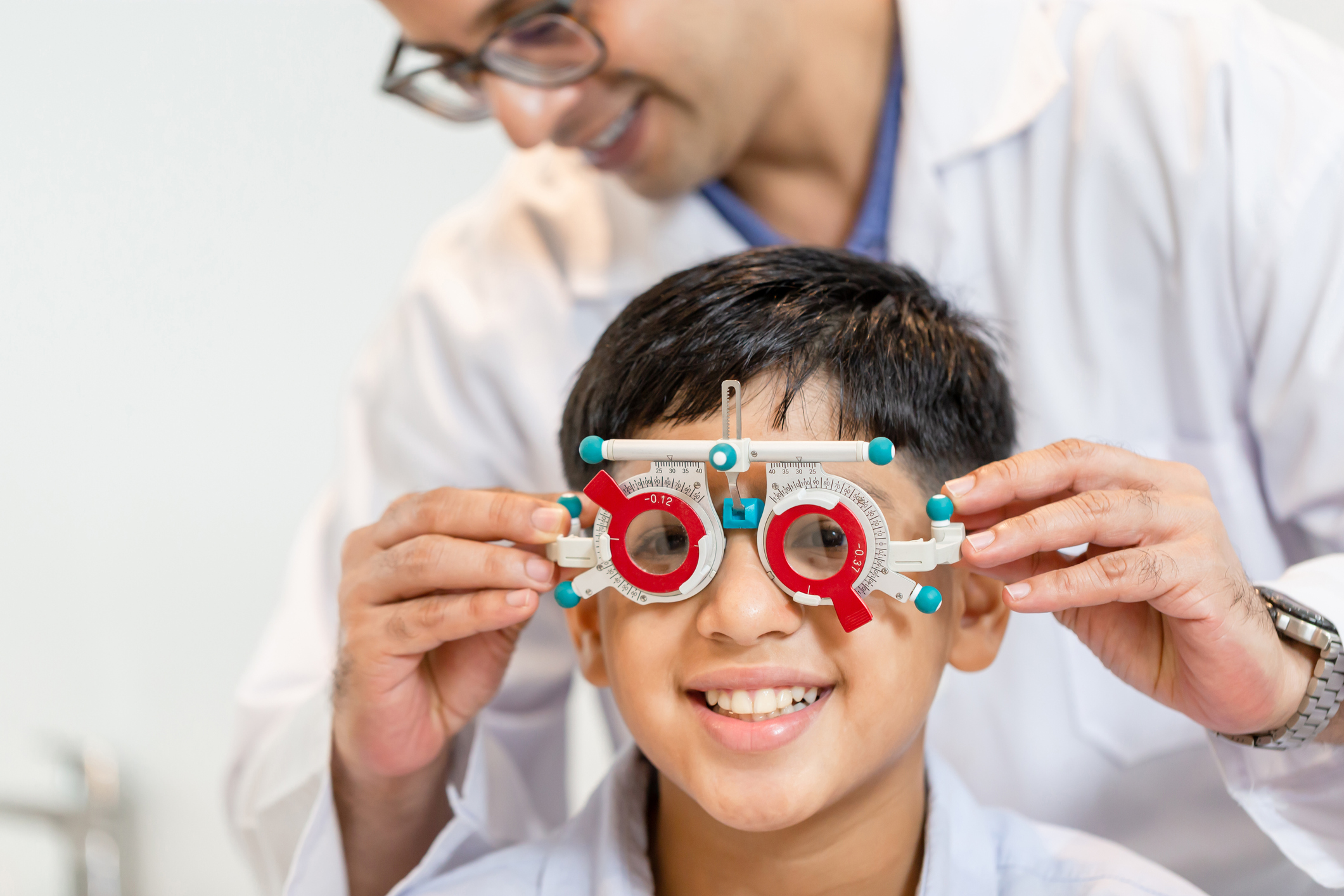Squint or Strabismus
- Strabismus is the condition in which the eyes are not aligned in the same direction.
- It usually develops before the age of 5, but may appear later .
- Children may or may not manifest this disorder.
- Due to a residual childhood squint, adults may develop this later in life.
- You should consult a child eye specialist for treatment if you notice that one eye of your child is turning in a different direction, up, down, inwards or outwards, whereas the other one is focussed on one spot.
- Left untreated, a squint may lead to further severe problems like blurred or double vision and lazy eye (amblyopia), which happens in early childhood where the eyesight doesn’t develop properly in one eye.
Treatment
The two most common types of squint are esotropia – where an eye turns in and exotropia – where an eye turns out.
Congenital or infantile estropia, wherein infants develop estropia within the first six months of life usually have a large noticeable inward turn. The chances of developing
normal binocular vision and depth perception are not good, and the child may not develop full vision in the weaker eye. However, the best chance is with early surgery, before 18 months of age. Multiple procedures may be required to obtain perfect alignment.
Accomodative estropia occurs in children usually after age two and is treated with glasses. These children are farsighted and have the ability to focus their eyes enough to adjust for the farsightedness, which allows them to see well, both near and far. Some children excessively strain their eyes when they focus, which causes one eye to turn in. Wearing glasses to correct their farsightedness reduces the need to focus and straightens their eyes. Sometimes bifocals need to be added to further reduce the need to focus when looking at closeby objects.
Pediatric Cataract
- Pediatric cataracts can develop in one eye or both eyes.
- They can occur at birth or later.
- They can be complete or partial, and partial cataracts can later progress to become a bigger problem.
- Cataracts are specially a challenge in children as early visual rehabilitation is critical in preventing lazy eye, which is irreversible.
- The earlier the onset of cataract, and the longer the duration, the worse is the prognosis.
- Children born with cataracts are also at risk for developing glaucoma, strabismus, nystagmus, and poor stereopsis, further complicating successful outcomes.
- One eye or unilateral infantile cataracts are rarely caused by a disease, except in some cases of intrauterine infections such as rubella.
- Two eye or bilateral cataracts are often inherited.
- Monocular congenital cataracts mostly have a good prognosis if surgery and vision correction is done by two months of age. Beyond this age, there is a possibility of having dense amblyopia in the operated eye.
Treatment
The treatment plan for pediatric cataracts is worked out after a careful eye examination and special tests. Dense bilateral congenital cataracts require urgent surgery and visual rehabilitation. In general, bilateral cataracts operated prior to two months of age have a good visual prognosis with approximately 80% achieving vision of 20/50 or better.
- Surgical: Cataract surgery in children is done under general anesthesia. It involves removal of the cataractous (opaque) crystalline lens. This is often accompanied by surgical measures to ensure the clarity of the central visual axis in the postoperative period, which can otherwise get obstructed by the ‘after cataract’ (collection of inflammatory cells and fibrous tissue) formation.
- Lenses: The use of aphakic glasses or contact lenses is the treatment for congenital cataracts in neonates, while an IOL (Intraocular Lens) implant is preferred for children over one year of age. The child will still require glasses after the IOL implantation after the operation. The child may require occlusion therapy for management of amblyopia.
Amblyopia
- Amblyopia or ‘Lazy Eyes’ is simply defined as a decrease in uniocular or binocular vision, even after spectacle correction, for which there is no apparent organic cause.
- It is commonly caused from conditions that produce a blurred image on the retina (e.g. congenital cataract which obstruct the light from entering the eye; high refractive errors) or abnormal binocular coordination of the two eyes (deviation of eyes) or combination of both (unequal refractive errors between the two eyes, astigmatic refractive errors).
- Amblyopia occurs between the ages 0-8 years, which is the critical period of development of the visual system. A patient has to undergo a complete eye examination to rule out any organic cause of loss of vision before a diagnosis of lazy eyes.
Treatment
Amblyopia is treatable in certain cases and early treatment is critical for best results.
- The first step is to clear the retinal image by giving appropriate glasses or by removal of media opacities like cataract or corneal opacities.
- The second step is to correct ocular d ominance, if present, by stimulating the weaker eye by forcing fixation to it.
- This is done by covering (patching) the good eye or by blurring the image in the good eye (by some drugs or by altering the spectacle number). Once Amblyopia is diagnosed, it has to be managed by strict vigilance and therapy.
Watery eyes
- Infants who have a nasolacrimal duct obstruction have watery eyes, an increased tear lake, mucus in the nasal corner of the eyelids and matted eyelashes.
- This is due to improper canalization of the nasolacrimal duct pathway, which drains tears from the eyes to the nose.
- Congenital nasolacrimal duct obstruction is common and occurs in 1 to 5% of the population, with approximately 1/3 occurring in both eyes.
Treatment
For the first six months of age, watery eyes are managed by a combination of nasolacrimal sac massage and periodic topical antibiotics.
In case the lacrimal massage fails to open the obstruction, syringing and probing is done. The child is given general anesthesia and a small steel wire is passed through the punctum into the nasolacrimal system, and down out into the nasal cavity. This does not hurt, nor does it create any problem in the nose. The success rate for a single nasolacrimal duct probing is approximately 90%. It might need to be repeated a few times to relieve the obstruction. If nasolacrimal duct probing fails, intubation with silicone tubes is done. If none of the above procedures provide relief, the child may require a dacryocystorhinostomy (DCR) procedure at around 3.5 to 4 years of age. This involves making an alternate bypass between the tear drainage system and the nasal cavity.
Red eye/Pink Eye
- “Red Eye,” or conjunctivitis simply indicates conjunctival inflammation. • Most children who have red eyes will have simple conjunctivitis. • Other causes of a “red, teary eye” in a newborn include congenital glaucoma and nasolacrimal duct obstruction.
- The most common causes for the pediatric pink eye are allergic conjunctivitis, bacterial conjunctivitis, viral conjunctivitis, and blepharitis (inflammation of lid margins).
Symptoms
- Crossed eyes.
- Keeps the object close to his eyes.
- Not being able to see the blackboard at school.
- Things looking blurry or funny.
- Feeling an itching, burning or scratchy sensation in the eyes.
- Injury to the eye.
- One or both the parents wear glasses.
- Frequent headaches along with watery or red eyes, recurring inflammation or irritation in the eyes
- Easy susceptibility to different types of eye infections
Treatment
- Typically the child eye specialist will do a refraction test with dilated pupils to examine the eyes to see if the child would require any prescription glasses
- Eye conditions are treated with a mix of corrective eyeglasses and visual aids, medical therapy and surgery if required.
FAQs
When does a child need an ophthalmologist’s checkup?
Children by 2.5-3 years of age should have a basic eye examination, irrespective of symptoms. There should be annual routine eye checkups post that. If the child complains of eye-ache, difficulty in reading or soreness or irritation in eyes one, should consult a child eye specialist.
What happens in an appointment with the child eye specialist?
The child eye specialist will start by doing a basic examination of the eye. If required, a dilated evaluation will be done. Dilation can be done either in the same visit (takes around 1.5-2 hours), or a home dilation may be recommended.
Does a squint go away on its own, without external treatment?
Squints in infants and young children sometimes improve with age. But always consult a paediatric ophthalmologist if you notice squint in your child.
Are squint eye exercises helpful in dealing with the condition?
Practising eye exercises, as recommended by the child eye specialist, may help in aligning eyes in some cases. Squint eye exercises in a vision treatment plan, customised for the child, are advised only after a thorough eye examination.
Squint eye exercises aim to improve the coordination of the eyes and to delay the need for surgery. They can be done at home or as suggested by the expert. Some of the widely known squint eye exercises are:
- Pencil exercise
- Brock string exercise
- Pencil pushups
- Machine-based exercises
What is the duration of a squint correction surgery?
The duration depends upon the number of muscles to be operated, the procedure planned and the type of anaesthesia to be used. On an average, it takes 1 hour or so.
How is the squint surgery performed?
Squint surgery is performed under local or general anaesthesia. It depends upon the age of the patient and complexity of squint. Squint surgery for children requires a lot of precision and care. Squint surgery involves either weakening the muscle by a procedure called recession (where it is inserted at a point behind the original insertion) or strengthening it by resection (shortening the muscle-tendon length) so that it becomes taut.
Are there any complications of squint surgery?
Though complications are rare, squint correction surgery might include infection of the eyeball and retinal detachment.
What is Pseudo-strabismus?
Pseudo-strabismus is a common condition that needs to be distinguished from deviation of eyes (true strabismus). With pseudo-esotropia, the infant usually has a wide nasal bridge and wide, prominent lid folds, which makes it look like the eyes are crossing. But, in fact, the eyes are straight. When the child looks to either side, the eye hides behind the eyelid folds or wide bridge and looks like they are crossing. It is important to document proper eye alignment in these cases by an orthoptic examination. Comprehensive eye examination and follow-ups are important for
patients diagnosed with pseudo-strabismus, as a small percentage of these patients will develop true esotropia.
What are the latest advances in Intraocular Lens (IOL) technology?
Advances in IOL technology have made various state-of-the-art IOLs available. The new lens designs include 1) Blue-light blocking IOLs that filter out harmful ultraviolet radiation as well as blue light, 2) Aberration-free IOLs which greatly improve image quality by enhancing contrast, eliminating glare and halos, and improving night vision, and 3) the newer Multifocal IOLs which provide good unaided distance and near vision with less dependence on glasses. 4) Toric IOLs are also available for the correction of high cylindrical spectacle numbers. Depending on the patients’ visual needs, the surgeon decides the most appropriate lens to implant in the eye.

